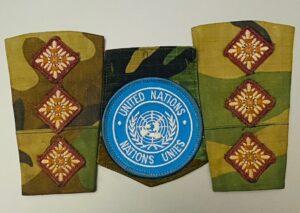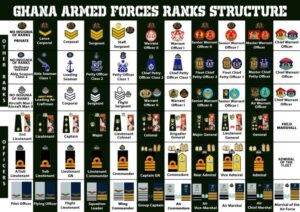
Of Ranks and Respect, Titles and Towels, Military and Medicine
To be in military service—Army (land), Air Force (sky), Navy (sea)—is no small thing. Of whatever nation. And to progress in rank is not a given. I know this for a fact as a young military enthusiast who began his medical career as a Civilian Employee of Ghana’s Ministry of Defence at the 37 Military Hospital in Accra. In my third year there, I would end up with an unforeseen honorary rank as Captain after a special duties course to be able to serve as the lead physician at the United Nations Level II Hospital in Bouaké that the Ghana Armed Forces was responsible for as part of the United Nations Operation in Côte d’Ivoire. Those were the dark days of the Ivorian civil war, in the mid 2000s.
At this time of unfortunate military malfunction—understandably resulting in all sorts of aspersions and conspiracy theories—it is worth putting on record that while the Ghana Armed Forces may not be the most powerful or most sophisticated military globally, they are highly regarded for their professionalism, discipline, and contributions to regional and global peacekeeping, especially United Nations peacekeeping operations.
Anyone who knows me well can testify that I’m not so much into titles but very much into towels (humble service, servant leadership). However, I have witnessed photos and reports of Ghana’s trending tragic eight-person helicopter deaths by civilians who don’t joke with their Prof/Dr/Rev/Alhaji/Ing etc. titles yet totally disregarding the hard-earned ranks of the three departed members of our Ghana Armed Forces. I want to believe it is out of sheer ignorance or carelessness and not intentional spite, for most people—I’ve come to believe in life—will do better when they know better. So here’s to doing better:
NON-COMMISSIONED OFFICERS RANKS
First of all, all military folk are either commissioned officers (with their ranks on top of their shoulders) or non-commissioned (with their ranks—jokingly called ‘chicken legs’—on the sides of their biceps). The usual parlance that distinguishes the two categories is “Officers and Men” or “Officers and Other Ranks” although in the strictest sense both categories are officers, one commissioned and the latter non-commissioned.
The said Wednesday August 6, 2025 helicopter disaster involved two Commissioned Officers (Squadron Leader Peter Anala and Flying Officer Manaen Twum Ampadu) plus one Other Rank (Sergeant Ernest Addo Mensah). With the Other Ranks, on passing out from the Training Centre the recruit starts as a Private in the Army (or Aircraftsman I and Aircraftsman II in the Airforce).
Progression from Private (Aircraftsman) is to Lance-Corporal (Leading Aircraftsman) then Corporal (same in Airforce) to Sergeant (also same) and then Staff Sergeant (Flight Sergeant) before finally Warrant Officer Class Two (same) and Warrant Officer Class One (same). Beyond that may be Senior Warrant Officer II, Senior Warrant Officer I, Master [Air] Warrant Officer and Chief Warrant Officer. This implies that the Sergeant level was the late Sgt. Ernest Addo Mensah’s fourth rank (or even fifth, if you consider that the Airforce has two levels of the Private rank) since enlisting in the Ghana Armed Forces. He was actually a Senior Non-Commissioned Officer at that rank. Respect!, throw a salute!
Military Ranks of Non-Commissioned Officers (‘Other Ranks’’) of the Ghana Armed Forces
| Army | Airforce | Navy |
| Private | Aircraftsman I Aircraftsman II |
Ordinary Seaman Able Seaman Class 2 |
| Lance Corporal | Leading Aircraftsman | Able Seaman Class 1 |
| Corporal | Corporal | Leading Seaman |
| Sergeant | Sergeant | Petty Officer Class 2 |
| Staff Sergeant | Flight Sergeant | Petty Officer Class 1 |
| Warrant Officer II | Warrant Officer II | Chief Petty Officer Class 2 |
| Warrant Officer I | Warrant Officer I | Chief Petty Officer Class 1 |
| Senior Warrant Officer II | Senior Warrant Officer II | Fleet Chief Petty Officer 2 |
| Senior Warrant Officer I | Senior Warrant Officer I | Fleet Chief Petty Officer 1 |
| Master Warrant Officer | Master Air Warrant Officer | Master Chief Petty Officer |
| Chief Warrant Officer | Chief Warrant Officer | Chief Warrant Officer |
COMMISSIONED OFFICERS RANKS
As for the Officers, the inadvertent rank disrespect I’ve witnessed by these ‘idle civilians’ (as soldiers tongue-in-cheek call non-military citizens) tends to be the case because the Air Force ranks are less commonly known to the ordinary man and apparently don’t carry the same level of gravitas as their army equivalent. In today’s parlance, they’re not as ‘sexy.’ In my opinion, quite frankly the Navy Officers’ ranks are even worse.

I still keep my captain shoulder straps or epaulets in my carry-on luggage for sentimental reasons
On commission, after meeting all the requirements over a period of study, the trainee (Officer Cadet) becomes a Second-Lieutenant in the Army, or the equivalent of Pilot Officer in the Air Force or Acting Sub-Lieutenant in the Navy. So here’s what we’ll do: let’s list the Commissioned Army Officers levels along with their Air Force equivalent in brackets: Second Lieutenant (Pilot Officer) to Lieutenant (Flying Officer) then Captain (Flight Lieutenant) to Major (Squadron Leader) and then Lieutenant Colonel (Wing Commander) before Colonel (Group Captain) and finally Brigadier-General, One Star (Air Commodore) to Major-General, Two-Star (Air Vice-Marshal) to Lieutenant-General, Three-Star (Air Marshal) to General-of-the-Army, Four-Star (Air Chief Marshal) and finally Field Marshal.

Infographic on Ghana Armed Forces Ranks Structure Source in the ‘Daily Graphic’
What this means is that the late Flying Officer Manaen Twum Ampadu was a junior Commissioned Officer and Squadron Leader Peter Anala a senior one. This was Ampadu’s second rank since his commissioning and was one step away from Flight Lieutenant (or Captain equivalent, in the Army). Anala on the other hand was a Senior Officer on his fourth pedestal (Major equivalent in the Army), a step ahead of Flight Lieutenant/Captain. After Captain/Flight Lieutenant, the officer moves into the Senior officer zone after promotional examinations taken along the line for advancement or otherwise. According to Brigadier-General (Rtd.) Dan Frimpong, “Subject to passing Promotion Examinations, it takes six years to become a Captain, and an additional five years to become a Major (eleven years in all).” For perspective, he adds, “It took me twenty-six (26) years to become a Colonel.”
Military Ranks of Commissioned Officers of the Ghana Armed Forces
| Army | Airforce | Navy |
| Second Lieutenant | Pilot Officer | Acting Sub Lieutenant |
| Lieutenant | Flying Office | Sub Lieutenant |
| Captain | Flight Lieutenant | Naval Lieutenant |
| Major | Squadron Leader | Lieutenant Commander |
| Lieutenant Colonel | Wing Commander | Commander |
| Colonel | Group Captain | Naval Captain |
| Brigadier-General | Air Commodore | Commodore |
| Major-General | Air Vice-Marshal | Rear Admiral |
| Lieutenant-General | Air Marshal | Vice Admiral |
| General | Air Chief Marshal | Admiral |
| Field Marshall | Marshal of the Air Force | Admiral of the Fleet |
THE MEDICAL & MILITARY IRONY OF HON. BOAMAH AND MYSELF
Interestingly, Hon. Dr. Edward Kofi Omane Boamah, Ghana’s deceased Minister of Defence who was on the fatal flight, and I both did our medical housemanship at the 37 Military Hospital in Accra. We had been mates at the University of Ghana Medical School since our admission in 1999 and shared some adventures together which I’ll bring forth in a different write-up.
When I got news that he had been nominated by H.E. President John Dramani Mahama as Ghana’s new Minister of Defence (later to be approved by Parliament on January 30), I sent him a January 22 WhatsApp message to which he cheerfully responded as follows:
Me: Defence!! Congratulations
Omane: Thanks Yaw
Me: Back to 37
Omane: Yes oooo… How life throws you back sometimes but in a different way.
The once-upon-a-time Civilian Employee of the Ministry of Defence had returned to lead the entire ministry. In my books, leading means being response-able, influencing and serving people towards a shared, noble purpose. Who would’ve thought that Dr. Boamah’s figurative “how life throws you…sometimes but in a different way” comment about his return to serve our military was also prophetic as the Z9 military helicopter he would be travelling barely 6-7 months later would literally throw him, down into a hellish death. May my brother, classmate, adventure partner in politics and publishing, medical colleague, fellow Civilian Employee, friend and Minister of Defence rest in peace together with the serving military officers and leading civilians he was en route with.
CONCLUSION
I started off this article as a purely educational one for those who needed a better appreciation of the world of military ranks. It has inadvertently ended in a tribute to the fallen, especially to my medico-military mate. No matter one’s station in life or rank in their profession, note that what makes us is not titles but service, including what good contributions to humanity we make with titles when they’re bestowed on us. Real leaders are not so much into titles as they are into towels (humble service and influence, servant leadership), be they civilians or servicemen, officers or other ranks, juniors or seniors, medic or military mates.
Leadership is service, leadership is sacrifice; sometimes, the ultimate sacrifice (death). May the untimely, ultimate sacrifice of the eight fallen remind us that true leadership is not about us but for others, including some we might never see like generations unborn. May their dedication inspire us to lead with passionate vision, courage and selflessness.
REFERENCES
Frimpong, Dan. ‘The Ghana Military Rank Structure.’ Daily Graphic of July 2, 2023 https://www.graphic.com.gh/features/opinion/the-military-rank-structure.html
Naadi, Thomas, Danai Nesta Kupemba & Khanyisile Ngcobo. “Ghana investigators find ‘black boxes’ of helicopter that crashed and killed two ministers.” BBC News. https://www.bbc.com/news/articles/cq68911m1d5o
Wikipedia. Ghana Air Force.’ Wikipedia. https://en.wikipedia.org/wiki/Ghana_Air_Force
Wikipedia. Ghana Air Force.’ Wikipedia. https://en.wikipedia.org/wiki/Ghana_Army

